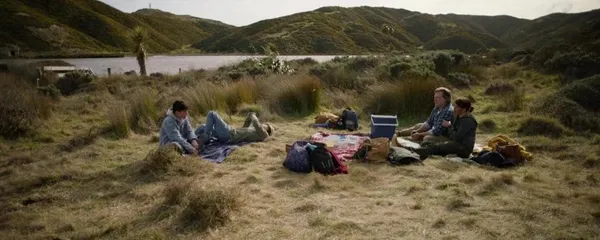 |
| Coming Home In The Dark |
In Maori director James Ashcroft's vicious début feature Coming Home In The Dark, high school teacher Alan Hoaganraad (Erik Thomson) is holidaying along the coast with his wife Jill (Miriama McDowell), and stepsons Maika (Billy Paratene) and Jordon (Frankie Paratene). When they cross paths with a pair of murderous drifters, Mandrake (Daniel Gillies) and Tubs (Matthias Luafutu), their idyllic getaway descends into a nightmarish fight for survival. What they’re not prepared for are the secrets from the past that will be dredged up.
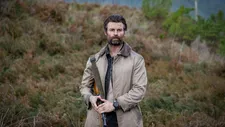 |
| Daniel Gillies as Mandrake |
In conversation with Eye For Film, Ashcroft discussed opening up space for the audience to enter the film, exorcising one’s demons through play, and being grateful to anyone who makes it past the 16 minute mark.
Paul Risker: Youth is a special time to discover film because at that age we’re sponges. We absorb everything, and as we get older how we relate to cinema changes. It’s not that we love film any less, but it’s a different experience. A film like Coming Home In The Dark can benefit from that childlike willingness to lose ourselves in the story, but it needs that analytical adult mind.
James Ashcroft: I've never thought about the pros and cons of both viewers, and what the overlap is, but that’s the space you want to be in as a filmmaker, and especially as an actor. All actors need an innate sense of joy to their playing, but not at the expense of telling the story for the audience.
You need to navigate those two paths and it’s the same as a filmmaker or a writer. You have to be able to occupy different points of view, navigating a more objective or subjective point of view from the audiences perspective, that you want them to have.
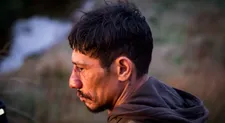 |
| Matthias Luafutu as Tubs |
The great thing with a child's mind is they allow themselves to be immersed and to buy in very quickly, and in a very faithful and true way. As long as you can hold them in that space, they'll stay there. How I remember performing on stage, or in the school shows is that there's nothing more honest than a children's audience. You might perform in the West End, but if you've paid $75 dollars for a ticket, chances are you're going to sit there and abide by the decorum. You’re going to clap because you've paid, whereas with a child, you have them until you don’t.
There's something very pure about that commitment to and immersion in a story. We're quick to pull out of a film or a story as an adult because of our analytical mind.
… I love stories that trust the audience to intuit, so you don't need to spoon feed or provide resolutions. It’s important to provide the stimulus for them to make up their own mind, or land in an area that you want them to land in. Not that I think you should spoon feed children, you should respect them in the same way, but I see a lot of films where there's no space for me to interpret or to relate, because everything is being shut down. There are no questions, all the answers are being provided. It’s the biggest and most consistent mistake I see in cinema.
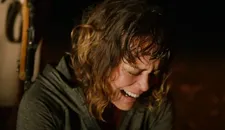 |
| Miriama McDowell as Jill |
PR: The story of a family preyed on by these two violent men initially appears to be a closed film, until the moral drama opens up a space for the audience. We’re asked to decide how we feel about characters, both the protagonist and antagonists, that blur the moral boundaries.
JA: … There's a word in Maori called 'porangi', which literally means to be mentally unwell. I'm drawn to the metaphoric definition of the word that splits in two: 'Por' meaning night, and 'angi' meaning day. Metaphorically it means to walk that line between night and day.
Most of the work I'm drawn to inhabits that grey space of porangi. Why I'm drawn to it is that it’s what we all reconcile with throughout our lives, and especially in that stage of moving from adolescence to adulthood. It’s the grey space where your world was once polarised, but then you realise it's more complex than that, and it's difficult to navigate. I don't think that ever ends.
These are the sorts of films I've been drawn to and with this film in particular, I had in the back of my head Sam Peckinpah's Straw Dogs (1971), and if you were to squint, Ted Kotcheff's Wake In Fright (1971). There were a lot of films in the Seventies from England and the US that played in that grey space. Their characters were morally grey, and what they were exploring were grey thematics that I find more compelling because they’re less didactic than a lot of films are today. If something is black and white, that's basically saying there are two options, and they're only advocating for one, which is the good.
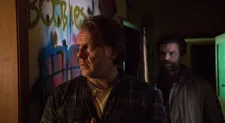 |
| Erik Thomson as Hoaggie |
… People aren't black and white, they’re grey and we have an urgency and desire to shut down discussions because we want a right answer. We want to know who to blame, and we want to be able to put ourselves firmly in a comfortable space of being right. It's a trap and it's a dangerous space to be in.
The grey space allows for conversation, it allows us to potentially be a lot more empathetic. Don't get me wrong, Mandrake and Tubs are definitely responsible for their horrendous actions, and in real life people like that need to be held accountable, however, it's not about right and wrong. It’s about opening up who they are and the complexities of people, so you can't write them off as quickly or as righteously as you often might. These days I often feel you might see a lot more of this desire for the righteous validation of being on the right team, in the right corner, voting for the right party, rather than, “Let’s unpack what's right in front of us.”
PR: A part of us is drawn to these seductive characters, that taps into the Jungian shadow complex. Cinema is a moral playground, where we can indulge in our anti-social desires vicariously through the characters onscreen. It’s a liberating experience, but it’s one that speaks to our darker natures.
JA: It's very liberating to have those shackles removed for an hour and a half, and that's what children do in play right? It's what the best actors do in finding the truth of the character. They’re also liberating themselves to play in that area of the profane, of the donning a cape and flying, and being a hero. Part of the power of storytelling is that you get to exorcise some of those demons. I know I do as a storyteller and I know Daniel and Matthias revelled in that freedom.
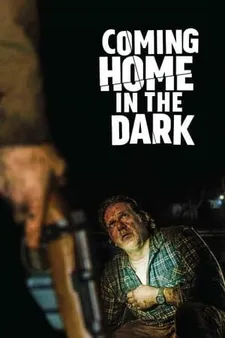 |
| Coming Home In The Dark poster |
If you can seduce people, if you can make that invitation and get them in, and then stick something serious down their throats to digest afterwards. Outside of an hour and a half, and in life, that sheen would wear off pretty quickly. The seduction and charm that we're seeing and enjoying is only surface level. What's actually sitting just underneath that is the truth of who those characters are. It's a way to get people to listen and it's also about how we've perpetuated these myths that the bogeyman is charmless and mean; it’s only negative. No, people in real life regardless of what they do can be charming in a situation, and they can be intelligent.
With Mandrake and Tubs it was about showing a duality within the character. So yes, here's someone doing incredibly horrific things and at the same time is still able to be very personable and loquacious. They’ve a curiosity, albeit to their own ends, and that duality is essential to make a character more compelling. It gives them a sense of truth and interest from an audience and story perspective.
PR: The first time you approach the film you come in with certain expectations. The way the space is opened up for the audience, that surprise will not be there on a repeat viewing. How do you think a second viewing will play for audiences?
JA: I'm not expecting a huge amount of people to want to watch this film for a second time to be honest – it’s a tough ask. Anyone who watches past the 16 minute mark, I'm grateful for them staying. I've seen the film 1,500 times so I can't see the wood for the trees. The people I have talked to and have watched it again recently, the main feedback I'm getting is that they’re taking note of the nuance of what's happening between the characters, and what’s happening in those silent moments.
On the first viewing there are some moments that sock you in the jaw. It takes a little while to return back and see some of the subtleties. Tubs seems to be the one people are drawn to on that second viewing. He has a strong emotional arc throughout the film, it’s just not through the use of dialogue.
There are some subtleties that we definitely intended that are in there, and now the audience are over the initial shock and they’re accustomed to it, they’re able to pay attention to some of those things that happen in that in-between space. The film is dialogue heavy in parts, but there's a lot of silence, and it has a lot of subtlety in terms of what's going on between people in those moments.
Coming Home In The Dark is in US cinemas now.





















